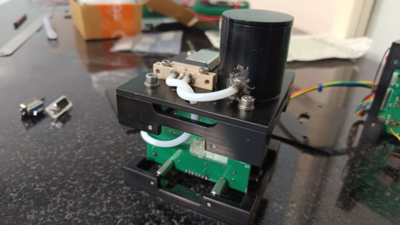[ad_1]
NEW DELHI: India’s first microbiological nanosatellite RVSAT-1, which was launched on board Isro’s PSLV C-60 last December as part of the SPADEX/POEM-4 mission, has been designed and developed by a team of students of Bengaluru-based RV College of Engineering in order to explore the growth of the gut bacterium in space.
For the students’ group Team Antariksh, RVSAT-1 is more than a student project: “It is a leap into the future of space exploration”. Success at each stage of tests of the nanosatellite bolstered the team’s confidence and brought the team closer to their dream of sending their work into space. And it was finally realised when RVSAT-1 was launched into space on Dec 30 last year from Sriharikota.
Gut bacteria plays an important role in our health by helping control digestion and benefiting our immune system and many other aspects of health. To know how the gut bacteria functions in space will help Isro find ways to keep Indian astronauts healthy during space missions.
H Nandish, a third-year aerospace student of the college who is engaged in RVSAT-1 project, told TOI, “Our satellite mission was only for three days. We collected a lot of data soon after the launch. The study was to measure the growth of gut bacterium, Bacteroides thetaiotaomicron, in space and how it behaved in zero gravity. Study of data will not only help in space medicine but will also provide clues for applications on Earth, such as advanced waste recycling systems and combating antibiotic resistance. Data will also help Isro find solutions to keep astronauts healthy for a long space journey.”
“We will publish a research paper after finding results from our nanosatellite data and put the report in public domain for its use by Isro, academia and others,” Nandish said, adding “data will basically help in astronaut health, waste management and antibiotic development.”
On growth of gut bacteria, Aditi Arun, project manager, who is also engaged in the satellite project, said, “The bacterial growth curve is plotted utilising optical density measurement. This gives a quantitative measure of the variation of growth patterns in space.”
The journey of RVSAT-1 has been challenging. Miniaturising complex lab equipment like incubators and spectrophotometers into a 2-U nanosatellite was a daunting challenge for Team Antariksh. Its innovative design incorporated a state-of-the-art microfluidic set-up and a precise optical system.
The payload’s unique experiment, combining bacterial growth analysis with prebiotic supplementation, promises groundbreaking insights into maintaining astronaut gut health. RVSAT-1’s development faced moments of uncertainty. The rigorous testing phase demanded the highest standards of precision and performance. Each test-thermal vacuum (T-VAC), vibration, 1,500g shock test, and electromagnetic interference and compatibility — simulated the harsh conditions of space, pushing the payload to its limits.
Beyond the technical achievements, RVSAT-1 symbolises the power of collaboration and the boundless possibilities of student innovation.
[ad_2]
Source link



